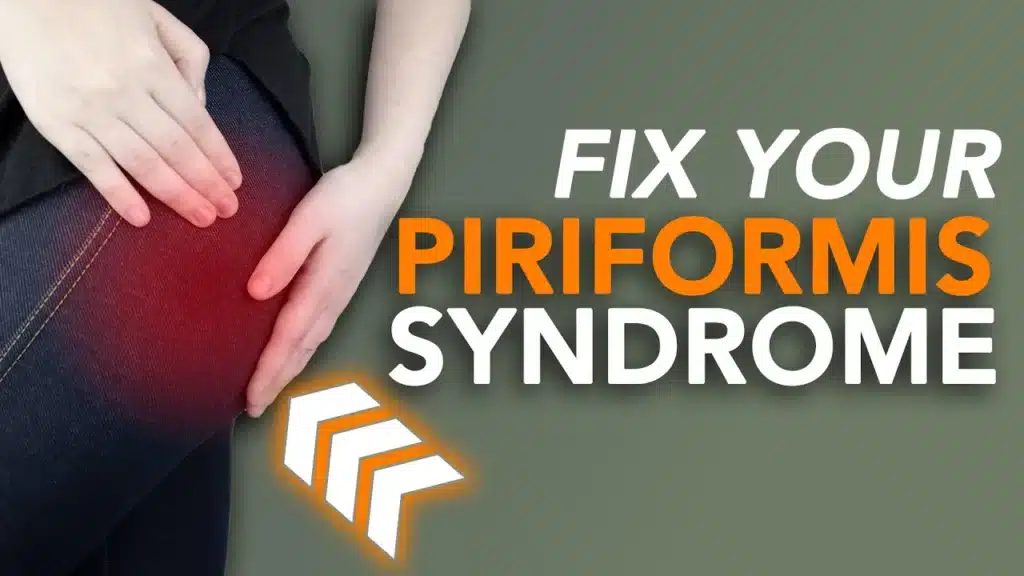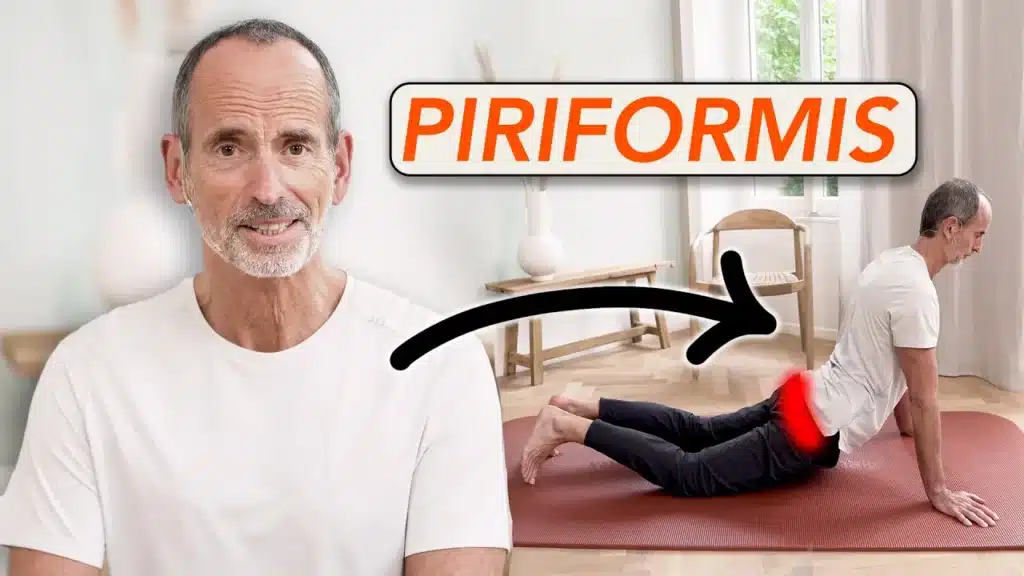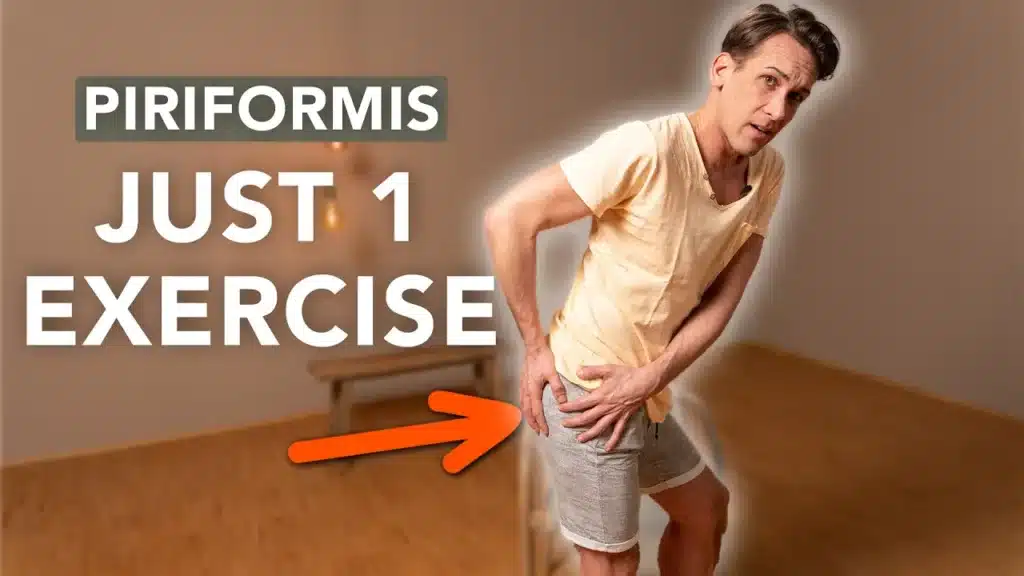
© Kjpargeter | shutterstock.com
Table of Contents
download your Free pdf Guide
Receive the 6 most effective exercises to relieve buttock pain and take care of your piriformis muscle!
Discover the best exercises to treat your pain - for free!
Join over 2.5 million people worldwide who are already using our unique therapeutic techniques. Download our FREE PDF guide with 6 simple exercises and see the results for yourself!
Start your pain-free life now.
Piriformis syndrome (sometimes referred to as deep gluteal syndrome) occurs when your piriformis muscle becomes inflamed and squeezes your sciatic nerve, causing pain in your buttocks and legs. The discomfort is described as an aching, burning, or shooting, down the back of the leg. 1)
This article can help. Keep reading to discover:
- where the piriformis muscle is and what it does,
- causes and symptoms of piriformis syndrome,
- the difference between piriformis syndrome and conditions that cause similar pain,
- how piriformis syndrome is diagnosed,
- treatment for piriformis syndrome,
- Liebscher & Bracht Exercises for piriformis syndrome.

Roland Liebscher-Bracht
Germany's most trusted pain specialist and author of several bestselling self-help books on the treatment of pain conditions.
Roland Liebscher-Bracht is Germany's most trusted pain specialist and author of several bestselling books on pain treatment. Together with his wife, Dr. med. Petra Bracht, he has developed a revolutionary method to treat pain conditions. With the help of the so-called "osteopressure", where you press specific points on your body, and special stretching exercises, pain can be stopped entirely without medication or surgical intervention. This pain treatment allows you to alleviate pain by yourself. Find out how exactly this works in this article or our numerous YouTube videos.
Roland Liebscher-Bracht
Germany's best-known pain specialist and author of several bestselling books on self-help against pain.
Roland Liebscher-Bracht is Germany's best-known pain specialist and author of several bestselling books on pain treatment. Together with his wife, the physician Dr. Petra Bracht, he has developed a revolutionary new form of pain treatment: With the so-called "Osteopressur", in which certain points on your body are pressed, and special stretching exercises, pain can be stopped completely without medication or surgical intervention. It is particularly important that this pain treatment gives you the opportunity to help yourself against your pain in a self-determined way. You can find out exactly how this works in this article and in the numerous YouTube videos.
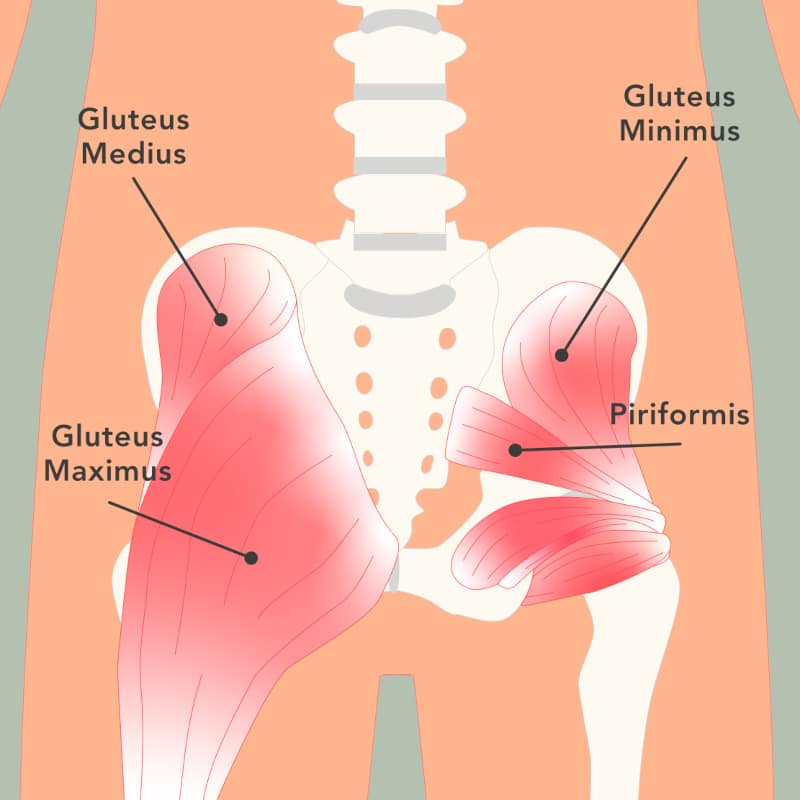
The piriformis is a flat muscle shaped like a pear (‘piriformis’ is Latin for ‘pear-shaped’) that runs through your gluteal region. One end of the piriformis is attached to your sacrum (a shield-shaped bone at the base of your spine connected to your pelvis), and the other to the greater trochanter of your femur (the very top of your thigh bone.)
The piriformis helps you abduct your thigh (move it away from your body), rotate it outward, flex your hip, and stabilize your posture when you stand and walk. 2)
Running under the piriformis muscle is the sciatic nerve, the longest and largest in your body. The sciatic nerve starts in the lower back and travels under the piriformis and down the back of each thigh. Just before the knee, the sciatic nerve splits into the tibial and common peroneal nerves, which run down the lower leg into the foot. The sciatic nerve is in a vulnerable position. If the piriformis muscle becomes inflamed, it presses on the sciatic nerve and disrupts the impulses that pass from it. 3)
A compressed sciatic nerve causes the tingling and numbness in your buttocks and the pain shooting down the back of your leg.
2. Causes of Piriformis Syndrome
Piriformis syndrome happens when the piriformis muscle becomes inflamed or spasms. Inflammation or spasms can be caused by:
- Inactivity. Most of us sit for far too long each day. We spend over eight hours perched on our office chairs, sit behind the wheel, and end our day on the couch. Prolonged sitting can weaken the piriformis muscle. If the muscle isn’t strong, running or climbing stairs can inflame the piriformis or cause it to spasm.
- Tight fascia. Fascia is a multi-layered connective tissue that surrounds and supports our muscles, ligaments, tendons, tissues, organs, nerves,bones and joints and responds to different kinds of stimulants. 4) Healthy fascia is supple, slippery, and flexible; it stretches when we move. If your fascia is unhealthy, it’s gummy, tense, and matted. Unhealthy fascia can restrict movement. Poor posture, leading a sedentary lifestyle, overworking your muscles, and dehydration can compromise the health of your fascia.
- Overexercising or playing a sport that requires repetitive movements.
- Poor form when lifting heavy objects.
- An injury to the hip, buttocks, or leg.
- Not warming up thoroughly before exercise or sports.
3. Symptoms of Piriformis Syndrome
Symptoms of piriformis syndrome are:
- Pain when sitting, standing, or lying for longer than 15 to 20 minutes. 5)
- Lower back pain. Between 0.3% and 6% of lower back pain cases are because of piriformis syndrome. 6)
- Pain and/or burning or tingling in your gluteal area that radiates down the back of the thigh and stops just above the knee.
- Pain that gets better with movement and gets worse when you stop moving.
- Pain when you get up from a sitting or squatting position, climb stairs, rotate your leg outwards, or bend over.
- Difficulty walking.
- Your foot feels numb.
- Your leg on the affected side feels weak.
- Sciatica (see Piriformis Syndrome vs Sciatica below).
- Sacroiliac pain on the unaffected side. The sacroiliac joints attach the top sides of your sacrum to your pelvis. Sacroiliitis is a condition that occurs when one of your sacroiliac joints becomes inflamed. Piriformis syndrome is often underdiagnosed because the symptoms are very similar to sacroiliitis (also called sacroiliac joint dysfunction.) 7)
- Headache .8)
- Neck pain .9)
Repetitious unilateral movements (moving body parts only to one side), like jogging, can trigger symptoms of piriformis syndrome. Your posture and sitting position can make symptoms worse.
4. Conditions That Cause Similar Pain

Image of the sciatic nerve. © Lightspring | shutterstock.com
Piriformis Syndrome vs. Sciatica
Piriformis syndrome can be mistaken for sciatica because the symptoms overlap. If you’ve got sciatica, pain can happen anywhere along the sciatic nerve. You may experience discomfort in your lower back, buttocks, down the back of your leg, or your foot and toes. Sciatica can feel like an electric shock or jolt, a shooting or stabbing pain, numbness, or tingling. Your leg or foot may feel weak. Making a sudden movement, sneezing, or coughing can intensify sciatica symptoms.
The difference between piriformis syndrome and sciatica is the cause. Piriformis syndrome happens when the piriformis muscle compresses the sciatic nerve. Sciatica is a symptom 10) caused by a disorder like a herniated disc or spinal stenosis.

This is what a herniated disc looks like. © Lightspring | shutterstock.com
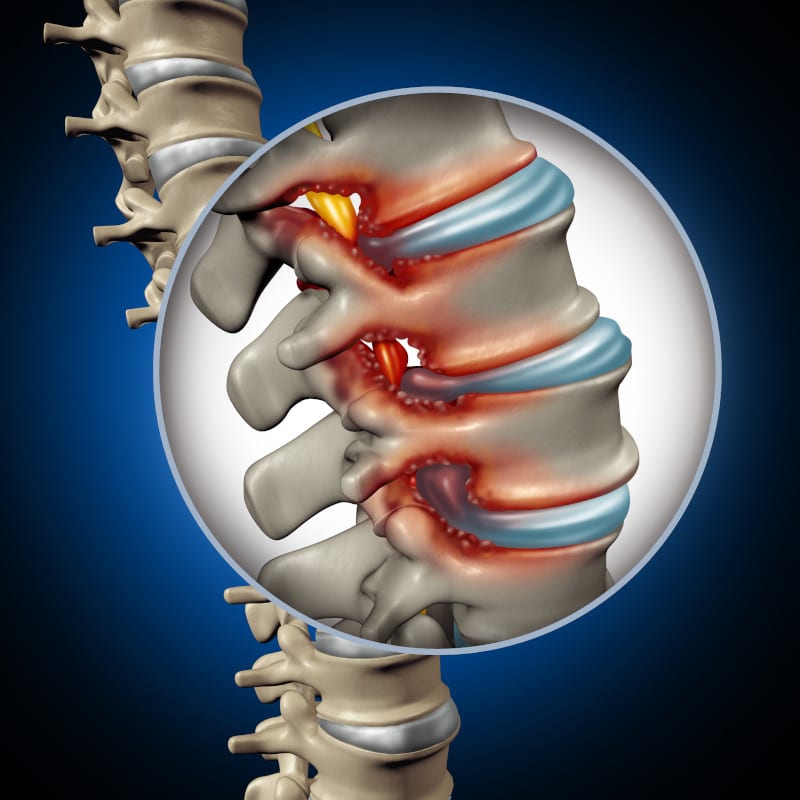
Picture of a narrowed spinal canal. © Lightspring | shutterstock.com
Herniated Disc and Spinal Stenosis
Herniated Disc
Your spinal canal is made up of 33 bones called vertebrae. In between each vertebra are flat cushions called intervertebral discs. These discs have a tough outside and a soft centre that has a similar texture to jelly. Your intervertebral discs absorb the shock of movement and help you to move easily. If a disc tears, the centre can leak out and press on one of the surrounding spinal nerves — but not the sciatic nerve. This is a condition called a herniated disc. It’s also known as a ruptured disc, slipped disc, or bulging disc. A disc can rupture anywhere along the spine, but it’s more common in the lower back. The symptoms of a herniated disc are lower back pain, buttock pain, pain in the thigh and calf and sometimes the foot. About 90% of sciatica cases are caused by herniated discs. 11)
Spinal Stenosis
Your spinal canal is a boney tube that houses the nerves making up your spinal cord. Spinal stenosis occurs when the space in the tube narrows, putting pressure on the nerves. The most common cause of spinal stenosis is osteoarthritis, a condition that happens when the cartilage between the bones breaks down. The bones may rub together, and new bones called bone spurs may grow. Bone spurs can pinch the spinal nerves. Other causes of spinal stenosis are spinal injuries, tumours, and thickened ligaments. Symptoms include back pain that travels to the buttocks and legs, numbness, tingling, weakness, and cramping in the legs. Your feet may feel numb, and you may have difficulty walking.
If you’ve lost feeling in your arms or legs, please seek medical attention immediately.
Relieve Piriformis Syndrome
Download our FREE PDF guide featuring our 6 most effective exercises against Piriformis Syndrome and buttock pain.

Diagnosing piriformis syndrome can be challenging because the condition shares symptoms with other ailments. If you visit your doctor to diagnose piriformis syndrome, they’ll ask you about your medical history, particularly if you’ve had any injuries to your hips or buttocks. They’ll ask what symptoms you’ve been experiencing and your overall level of physical activity. Your doctor may lead you through a sequence of movements, including stretching, pressing, and rotating the hip, butt and legs to see which motions cause pain and which do not. Although there is no test specific to piriformis syndrome 12), your doctor may order an ultrasound, CT scan, MRI, or EMG to rule out other conditions like a slipped disc. However, if you are experiencing lower back pain, the cause won’t show up on an MRI. 13)

© Alliance | shutterstock.com
6. Treatment of Piriformis Syndrome
In most cases, piriformis syndrome treatments focus on stretching and massaging the muscle. Pain management specialist Roland Liebscher-Bracht has developed exercises that can help relieve discomfort caused by piriformis syndrome. Check them out here.
While you are recovering, take a break from whatever activity brought on the piriformis pain. (Hang up those running shoes until the tingling and burning go away.) Improving your posture can also help with piriformis pain. (We have an exercise for that, too.)
Ice packs and heat therapy can alleviate pain short term. For long-term relief, focus on improving your posture, making lifestyle changes, and incorporating Liebscher & Bracht exercises into your daily routine.
If you visit a doctor, they may prescribe:
- Physical therapy
- NSAIDs (nonsteroidal anti-inflammatory drugs)
- Muscle relaxants
- Steroid injections
- Botox® injections
- Iontophoresis (treating the muscle with a mild electrical current)
If these treatments fail, surgery may be recommended.
Relieve Piriformis Syndrome
Download our FREE PDF guide featuring our 6 most effective exercises against Piriformis Syndrome and buttock pain.

7. Liebscher & Bracht’s Piriformis Syndrome Treatment
Liebscher & Bracht’s exercises for piriformis pain target tight muscles and fascia in the gluteal area with stretches and foam rolling massages. A study of long-distance runners who carried out foam rolling massages found a significant increase in the flexibility of their piriformis and surrounding muscles, as well as an improved range of motion. 14)
Performing the Liebscher & Bracht exercises regularly may help relieve piriformis muscle inflammation, take the pressure off of your sciatic nerve, and restore your mobility. Our treatments may help prevent piriformis syndrome from developing in the future.
Choose from one of our easy-to-follow routines:
Sources & Studies
- ↑1 Hicks BL, Lam JC, Varacallo M. Piriformis Syndrome. [Updated 2023 Apr 17]. In: StatPearls [Internet]. Treasure Island (FL): StatPearls Publishing; 2023 Jan-. Available from: https://www.ncbi.nlm.nih.gov/books/NBK448172/.
- ↑2 Boyajian-O’Neill, Lori A., McClain, Rance L., Coleman, Michele K. and Thomas, Pamela P.. "Diagnosis and Management of Piriformis Syndrome: An Osteopathic Approach" Journal of Osteopathic Medicine, vol. 108, no. 11, 2008, pp. 657-664. https://doi.org/10.7556/jaoa.2008.108.11.657.
- ↑3 Ahmad Siraj, S., & Dadgal, R. (2022). Physiotherapy for Piriformis Syndrome Using Sciatic Nerve Mobilization and Piriformis Release. Cureus, 14(12), e32952. https://doi.org/10.7759/cureus.32952.
- ↑4 Fede C, Pirri C, Fan C, Petrelli L, Guidolin D, De Caro R, Stecco C. A Closer Look at the Cellular and Molecular Components of the Deep/Muscular Fasciae. International Journal of Molecular Sciences. 2021; 22(3):1411. https://doi.org/10.3390/ijms22031411.
- ↑5,↑7,↑8,↑12 Boyajian-O'Neill, L. A., McClain, R. L., Coleman, M. K., & Thomas, P. P. (2008). Diagnosis and management of piriformis syndrome: an osteopathic approach. The Journal of the American Osteopathic Association, 108(11), 657–664. https://doi.org/10.7556/jaoa.2008.108.11.657.
- ↑6 Vij, N., Kiernan, H., Bisht, R., Singleton, I., Cornett, E. M., Kaye, A. D., Imani, F., Varrassi, G., Pourbahri, M., Viswanath, O., & Urits, I. (2021). Surgical and Non-surgical Treatment Options for Piriformis Syndrome: A Literature Review. Anesthesiology and pain medicine, 11(1), e112825. https://doi.org/10.5812/aapm.112825.
- ↑9 Boyajian-O'Neill, L. A., McClain, R. L., Coleman, M. K., & Thomas, P. P. (2008). Diagnosis and management of piriformis syndrome: an osteopathic approach. The Journal of the American Osteopathic Association, 108(11), 657–664. https://doi.org/10.7556/jaoa.2008.108.11.657
- ↑10 Valat, J. P., Genevay, S., Marty, M., Rozenberg, S., & Koes, B. (2010). Sciatica. Best practice & research. Clinical rheumatology, 24(2), 241–252. https://doi.org/10.1016/j.berh.2009.11.005.
- ↑11 Koes, B. W., van Tulder, M. W., & Peul, W. C. (2007). Diagnosis and treatment of sciatica. BMJ (Clinical research ed.), 334(7607), 1313–1317. https://doi.org/10.1136/bmj.39223.428495.BE.
- ↑13 Kasch, R., Truthmann, J., Hancock, M. J., Maher, C. G., Otto, M., Nell, C., Reichwein, N., Bülow, R., Chenot, J. F., Hofer, A., Wassilew, G., & Schmidt, C. O. (2022). Association of Lumbar MRI Findings with Current and Future Back Pain in a Population-based Cohort Study. Spine, 47(3), 201–211. https://doi.org/10.1097/BRS.0000000000004198.
- ↑14 Sulowska-Daszyk, I., & Skiba, A. (2022). The Influence of Self-Myofascial Release on Muscle Flexibility in Long-Distance Runners. International journal of environmental research and public health, 19(1), 457. https://doi.org/10.3390/ijerph19010457.

